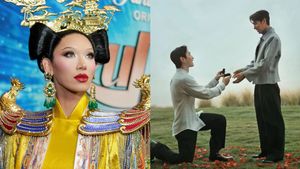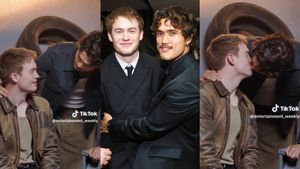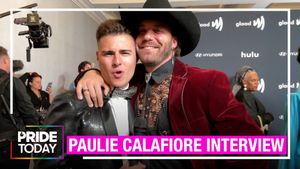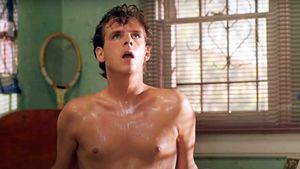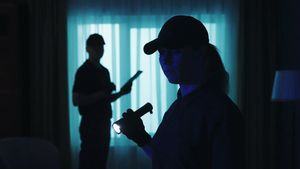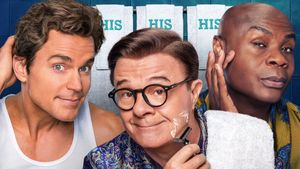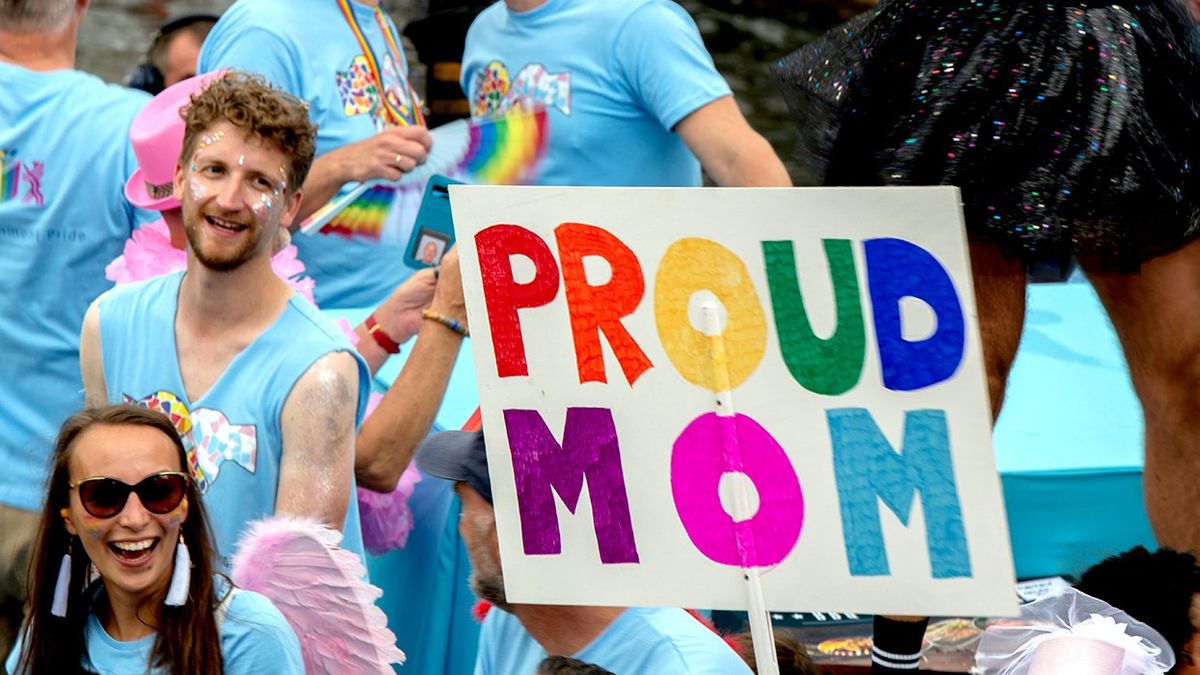AfterFlorida Republican Gov. Ron DeSantis pre-empted thelighting of state bridges in Pride colors, one Jacksonville man forged his own path to illuminating the roadway.
Keep up with the latest in LGBTQ+ news and politics. Sign up for The Advocate's email newsletter.
Matt McAllister spoke to The Advocate about how he rapidly organized 70 people to light up the Main Street Bridge over the St. Johns River. He hopes LGBTQ+ allies around the state and country can replicate the demonstration, which ultimately proved more moving than he ever dreamed. “I think this may be a tradition now,” he said of the Jacksonville bridge lighting.
The backstory
First, McAllister shared how quickly he brought together dozens of people in Jacksonville, many of whom he never met before putting a high-powered flashlight in their hands, in such a short time. News first broke in May that DeSantis had ordered all state bridges in red, white and blue from Memorial Day to Labor Day. Purportedly part of Florida’s ‘Freedom Summer,’ that effectively stopped many communities from a tradition Pride recognition, as well as activities like lighting bridges in orange for Gun Violence Awareness Day.
“It’s amazing how the lack of choice is sold to us as freedom,” McAllister said. “Orwell would blush.”
As it happens, McAllister was in Leipzig, Germany at the time, celebrating a honeymoon with his new husband in a city that not so long ago was in theEastern Bloc. Immediately he decided there had to be a citizen-led way of lighting bridges up despite the governor’s directive. He ended up on the phone with Orlando friend Andy Greene, CEO ofMyRadar, who liked McAllister’s idea so much he offered to spend $1,500 dollars on high-intensity flashlights.
McAllister soon ended up on the phone with friends involved in theater production, who advised him on the use of lighting gels to ensure light beams project in Pride colors. He learned from a friend in Chicago that Jacksonville was actually home to theStage Lighting Store, which primarily caters to online customers but could serve as a local source of high-quality gels. He purchased 20-by-24-inch sheets in the six colors of a rainbow flag, and advises using dark, deep hues to use with lights.
He ultimately taped those gels with a special poly hanging and seaming tape, which is used for affixing gels to stage lights.
In what he describes as pure “kismet,” McAllister sourced all he needed for the demonstration at a cost of only about $25 per person, providing a way to stage a bridge lighting on a budget.
Trial and error
McAllister still had to test his plan. He and a small group of friends originally tried out lighting in late May on an Interstate-95 bridge, but were so high off the water no reflection appeared, even. “It was the worst thing,” he said. “You could see it from anywhere.”
Ultimately, the Main Street Bridge seemed like a more attractive location for a number of reasons. For one, it wasn’t a state-managed bridge, so the flashlights wouldn’t have to compete with the red, white and blue lights blasted from Department of Transportation projectors. And in truth, McAllister didn’t want this symbolism of trying to drown out patriotic lighting anyway.
“Our goal wasn’t to wash out the red, white and blue, but to complement it,” he said. “the whole idea is that freedom and diversity only exist within the confines of each other. Without freedom, diversity cannot exist. And without diversity, freedom is an abstract idea that cannot be practiced.”
But the Main Street Bridge does have basic street lighting and wide pedestrian walking areas, something that would ensure the safety of participants in an activity that by necessity had to take place at night. McAllister stressed that anyone replicating the lighting should treat safety in high regard when putting dozens of pedestrians on bridges shining bright flashlights as cars drive by.
This bridge also seemed perfect for a political demonstration because there were viewing areas on both sides. In the end, several local media outlets captured the lighting itself, garnering national attention when McAllister and company pulled everything off.
In addition to making sure the bridge can be seen from welcoming vantage points, he also said to consider the surfaces on which light reflects. A bridge made of concrete, or even better a shining metal, will increase the amount of light that can be seen. That’s a trick McAllister learned talking to theater experts. During trial runs, he and his friends tried shining flashlights directly at the water, but that produced very little light. While photos of the Main Street Bridge lighting show a strong reflection on the St. Johns River, that’s from the light bouncing off the bridge itself.
Measuring manpower
Just to make sure the lighting had the strongest impact, McAllister asked friends with an engineering background to look at specs for the bridge and advise how much spacing should exist between each individual wielding a flashlight. He had planned to have 70 participants, and in the end, the Main Street Bridge had 69 marker posts along its pedestrian bridge that effectively divided the pathway evenly anyhow.
McAllister put the word out on social media, first in a gay kickball group on Facebook. Upon request, he made his post there sharable, and word spread quickly. By the evening of May 31, he had more than 70 people RSVP along with 30 others he asked to come in case of cancellations. The groups were organized with 11 to 13 people for each color, and McAllister assigned a leader for each group who was responsible for distributing the equipment and leading the group across the bridge.
Folks gathered at the bridge at 8:30 p.m.. Leaders led lines of people across the bridge to their proper locations, and set alarms for 9:19 p.m. on their phones, set to vibrate since car noise would be louder than ringers). At that point, leaders called for their color group to light up in unison.
The final result proved stunning.
“I would think the DeSantis administration ought to be handing us an award for the first mass example of freedom in Freedom Summer,” he said.
He’s not holding his breath on that, but does hear other activists in Florida could stage similar lighting later this month.







